Blender Game Engine Level Design
game design & content making tutorials for Blender and more...
Tutorials, training and educational resources for game making and development. Who needs school for game design when it can be done online!. Learn content creation, game art production, models, texturing, level design and more using Blender 3D.
Contents
- Blender content modeling
- Social & Virtual World
- Texture creation tutorials
- idTech editing tutorials
- Video tutorials
- gmax tutorials
- RtCW editing & misc.
- Trackmania Nations
Using the Blender tutorials and training available below, learn how to use Blender 3D for content creation, game making, design and development. Pick up essential skills for properly optimised models, efficient level design and texture making. In-depth, extensive and unique explanations of methods and principles you won't find anywhere else, seriously! Not just on using Blender 3D, but also the 'hidden' and less talked about core subjects associated with content and game development, all of if freely available to those looking for it.
Blender modeling tutorials ^
Social & Virtual World tutorials ^
Items mark [‡] below are hosted by IMVU in the Creator Education Center.
- Introduction to Blender
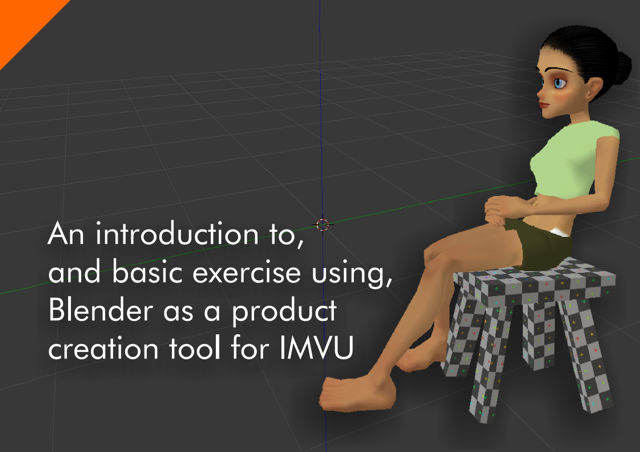 A simple exercise introducing Blender to new users, how it works and the basics of making and manipulating content.
A simple exercise introducing Blender to new users, how it works and the basics of making and manipulating content. - Shape Key (Morph) Animation
 Recorded live, make a simple morph animated accessory using Shape Keys in Blender. Source files also available.
Recorded live, make a simple morph animated accessory using Shape Keys in Blender. Source files also available. - Make an earring Accessory
 Recorded live on Twitch, watch how to make a simple earring accessory item for IMVU. Source files also available.
Recorded live on Twitch, watch how to make a simple earring accessory item for IMVU. Source files also available. - Make a Simple Handheld Accessory
 Recorded live on Twitch, watch how to make a simple giftbox accessory item for IMVU. Source files also available.
Recorded live on Twitch, watch how to make a simple giftbox accessory item for IMVU. Source files also available. - Product Lighting [‡]
 Learn about product lighting - where, how, colour - mainly for rooms but furniture, accessories and more.
Learn about product lighting - where, how, colour - mainly for rooms but furniture, accessories and more. - Idle Animations [‡]
 The state a product or avatar is in when it first loads is its 'Idle' position. It can be a single animation or series which loop.
The state a product or avatar is in when it first loads is its 'Idle' position. It can be a single animation or series which loop. - Export to Cal3D from Blender [‡]
 Although relatively obsolete for newer versions of Blender, Cal3D export for IMVU is still useful in some situations.
Although relatively obsolete for newer versions of Blender, Cal3D export for IMVU is still useful in some situations. - Adding Lights [‡]
 Learn about adding lights to products and the differences between Blender and IMVU that need to be kept in mind to work.
Learn about adding lights to products and the differences between Blender and IMVU that need to be kept in mind to work. - Skeletons & Bone Relationships [‡]
 All products have an underlying (invisible) skeleton built from bones that together form relationships with one another.
All products have an underlying (invisible) skeleton built from bones that together form relationships with one another. - Furniture Introduction [‡]
 Learn how to make, from start to finish, a simple textured furniture item for IMVU using Blender 3D.
Learn how to make, from start to finish, a simple textured furniture item for IMVU using Blender 3D. - See-Thru Rooms nodes [‡]
 Invisible nodes enhance rooms by hiding elements when viewed from specific angles. Learn how to set them up effectively.
Invisible nodes enhance rooms by hiding elements when viewed from specific angles. Learn how to set them up effectively. - Default Avatar Models [‡]
 The default avatar dummies are a crucial part of making content for IMVU, ensuring proper product scale and size.
The default avatar dummies are a crucial part of making content for IMVU, ensuring proper product scale and size. - Working with Room Cameras [‡]
 Cameras are a fundamental component of rooms that can do more than just provide a portal into a scene.
Cameras are a fundamental component of rooms that can do more than just provide a portal into a scene. - Cycling (looping) animation [‡]
 There are two types of animation in IMVU, singple play or looping. Learn about cycling sequences and how they work.
There are two types of animation in IMVU, singple play or looping. Learn about cycling sequences and how they work. - Rooms & Furniture Animation [‡]
 Rooms and furniture are not just static items, they can be animated to do thing provided some rules are followed.
Rooms and furniture are not just static items, they can be animated to do thing provided some rules are followed. - Animation & Avatar Actions [‡]
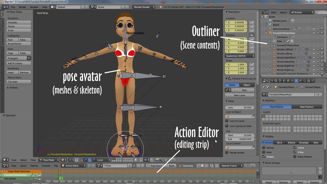 Avatar Actions are where static and animated poses are assembled, set-up and assigned to control the avatar.
Avatar Actions are where static and animated poses are assembled, set-up and assigned to control the avatar. - Basics of Animation in Blender [‡]
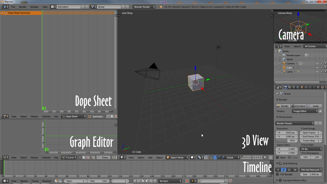 Learn more about animating using Blender, the Action Editor, keyframes etc., and what they mean for IMVU products.
Learn more about animating using Blender, the Action Editor, keyframes etc., and what they mean for IMVU products. - Furniture Seat Handles [‡]
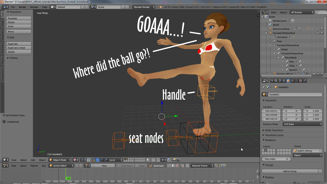 Seat Handles are the only element displayed to users, it doesn't need to be in the same place. Learn more here.
Seat Handles are the only element displayed to users, it doesn't need to be in the same place. Learn more here. - Furniture Catch & Pitcher Nodes [‡]
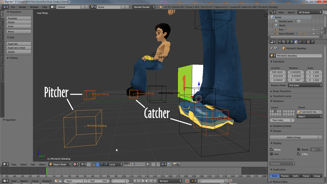 The Catcher and Pitcher nodes are used for interactive animations between avatars. Learn more about them here.
The Catcher and Pitcher nodes are used for interactive animations between avatars. Learn more about them here. - Weight Painting Furniture [‡]
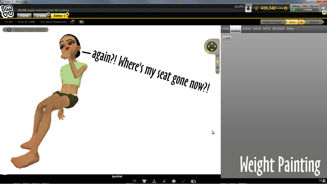 For any items to work in IMVU it needs to be linked to a Skeleton, done using Weight Painting in Blender.
For any items to work in IMVU it needs to be linked to a Skeleton, done using Weight Painting in Blender. - Furniture skeletons (nodes) [‡]
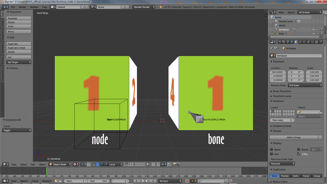 Furniture items are some of the simplest products to make on Blender but can include more. Find out here.
Furniture items are some of the simplest products to make on Blender but can include more. Find out here. - Rooms: working with furniture [‡]
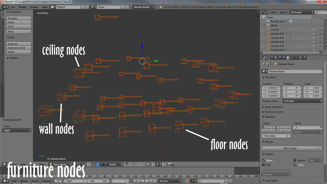 Furniture nodes are what make rooms rooms but there are several types and not all need to be used. Find out more here.
Furniture nodes are what make rooms rooms but there are several types and not all need to be used. Find out more here. - Rooms: working with seat nodes [‡]
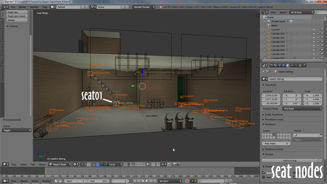 To add more interaction to Rooms, seats, or avatar pose spots, are an essential. Find out more here.
To add more interaction to Rooms, seats, or avatar pose spots, are an essential. Find out more here. - Basics of Avatar animation [‡]
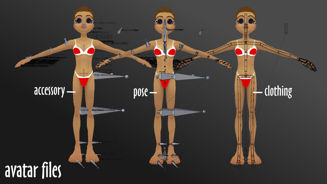 For Blender creators there are three avatar files but only one can be used to make poses. Learn more here.
For Blender creators there are three avatar files but only one can be used to make poses. Learn more here. - FBX export/import [‡]
 With FBX it's easier to export products for IMVU, simple furniture, pose and more with or without animation. Learn how.
With FBX it's easier to export products for IMVU, simple furniture, pose and more with or without animation. Learn how. - Add furniture seating [‡]
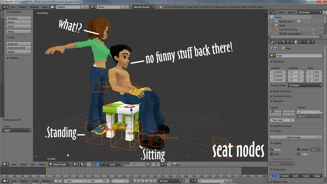 Find out how to add seating (default and custom) to furniture in Blender, how they trigger avatar poses when used.
Find out how to add seating (default and custom) to furniture in Blender, how they trigger avatar poses when used. - Materials in Blender [‡]
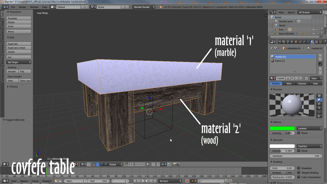 Learn how to work with and set-up Materials in Blender so meshes export with editable slots (in Create Mode).
Learn how to work with and set-up Materials in Blender so meshes export with editable slots (in Create Mode). - IMVU, Blender & Skeletons [‡]
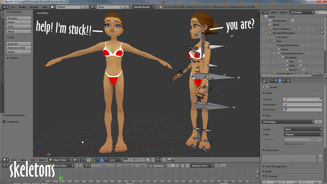 Learn more about how IMVU uses Skeletons and how products should be set up properly to use them in Blender.
Learn more about how IMVU uses Skeletons and how products should be set up properly to use them in Blender. - Mesh Smoothing (Smooth Shading) [‡]
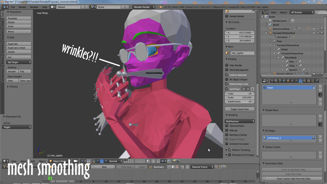 Mesh Smoothing is often overlooked but highly useful in making meshes appear more natural. Learn how here.
Mesh Smoothing is often overlooked but highly useful in making meshes appear more natural. Learn how here. - Vertex Painting & Colour [‡]
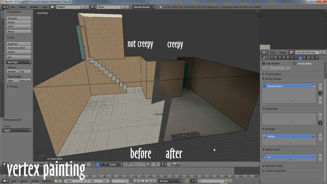 Vertex Painting is an effective way to add colour, tint or shade a mesh saving on textures. Find out more here.
Vertex Painting is an effective way to add colour, tint or shade a mesh saving on textures. Find out more here. - Understanding Weight Painting [‡]
 Understanding Weight Painting and how it relates to IMVU is important for the export of functional products.
Understanding Weight Painting and how it relates to IMVU is important for the export of functional products. - Nodes & Room skeletons [‡]
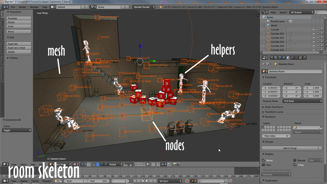 Furniture rooms are complicated, several types of node being used for different effect. Find out what and how they work.
Furniture rooms are complicated, several types of node being used for different effect. Find out what and how they work. - Camera Nodes for Rooms [‡]
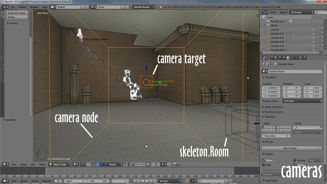 Learn more about camera nodes used in Rooms, how they can be edited to ensure they still work properly.
Learn more about camera nodes used in Rooms, how they can be edited to ensure they still work properly. - Avatar Materials [‡]
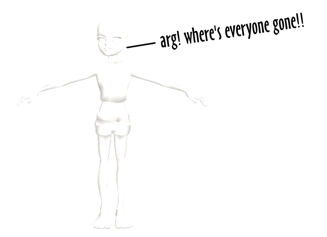 Find out how set up and assign Materials in Blender to produce editable meshes in IMVU's Create Mode.
Find out how set up and assign Materials in Blender to produce editable meshes in IMVU's Create Mode. - [‡] Avatar Files explained [‡]
 Learn about the Blender Avatar files, what they're for and how to make poses and other animated content for IMVU.
Learn about the Blender Avatar files, what they're for and how to make poses and other animated content for IMVU. - Quickstart - furniture [‡]
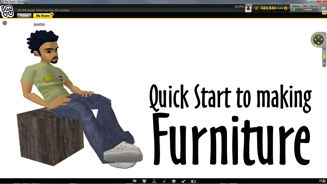 Learn to make, export and edit a basic furniture item for IMVU using the Blender Furniture Starter File.
Learn to make, export and edit a basic furniture item for IMVU using the Blender Furniture Starter File. - Using Paint 3D for IMVU
 Here's how to use Microsoft's Paint 3D app to make items for IMVU using the Export to FBX feature.
Here's how to use Microsoft's Paint 3D app to make items for IMVU using the Export to FBX feature. - How to make custom avatar poses
 Learn how easy it is to make custom stand-alone (not associated with other items) avatar poses (incl. example).
Learn how easy it is to make custom stand-alone (not associated with other items) avatar poses (incl. example). - Custom (node) furniture seats (FBX)
 With FBX import comes a brand new, and much easier, way to add seating (pose spots) to furniture (incl. example).
With FBX import comes a brand new, and much easier, way to add seating (pose spots) to furniture (incl. example). - Node-based furniture (FBX)
 A brand new way to make furniture items is now possible with the introduction of FBX to IMVU (incl. example).
A brand new way to make furniture items is now possible with the introduction of FBX to IMVU (incl. example). - How to import FBX into IMVU
 FBX is much easier to use to import assets into IMVU but some settings are needed to ensure they work as expected.
FBX is much easier to use to import assets into IMVU but some settings are needed to ensure they work as expected. - IMVU & FBX import scale
 FBX typically uses a different scaling system that makes Blender content too big. Find out how to compensate and fix this.
FBX typically uses a different scaling system that makes Blender content too big. Find out how to compensate and fix this. - Get Started with Blender for IMVU
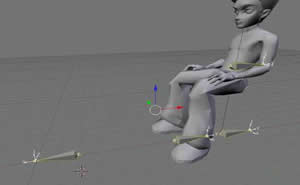 Essential guide to get started with Blender for IMVU. Valuable links, information and resources for budding Content Creator.
Essential guide to get started with Blender for IMVU. Valuable links, information and resources for budding Content Creator. - make IMVU furniture rooms
 Shows how to make a simple furniture room for IMVU. Bone placement, texturing, UVW and more (incl. source).
Shows how to make a simple furniture room for IMVU. Bone placement, texturing, UVW and more (incl. source). - Making IMVU furniture items
 An essential guide to using Blender to make IMVU furniture from start to finish and assembly in Create Mode.
An essential guide to using Blender to make IMVU furniture from start to finish and assembly in Create Mode. - Make IMVU furniture ( Blender 2.49)
 Learn the basics of making furniture items for IMVU using Blender 2.49a from start to finish (incl. source).
Learn the basics of making furniture items for IMVU using Blender 2.49a from start to finish (incl. source). - animated pets for IMVU
 Make a pet for IMVU with Blender 2.49. Positions for different types of Pet, textures and export (incl. example).
Make a pet for IMVU with Blender 2.49. Positions for different types of Pet, textures and export (incl. example). - IMVU Creator hints and tips
 A page dedicated to some of the more common hints and tips for IMVU developing (content creation) when using Blender 3D.
A page dedicated to some of the more common hints and tips for IMVU developing (content creation) when using Blender 3D. - proper Opacity Maps for IMVU
 Learn to properly set-up an Opacity Map for materials in IMVU's Create Mode using two simply images.
Learn to properly set-up an Opacity Map for materials in IMVU's Create Mode using two simply images. - (Obsolete)
opacity maps for IMVU
Learn how to properly set-up Opacity Maps in IMVU when the material system in Create More fails. - Make an IMVU product bundle
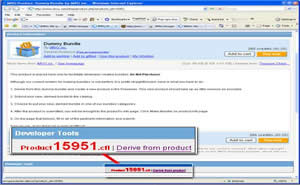 Following the simple steps outlined to make a proper IMVU (Content Creator) Bundle item containing other products.
Following the simple steps outlined to make a proper IMVU (Content Creator) Bundle item containing other products. - Make furniture items for Frenzoo
 Learn to properly set-up models for export and conversion to Frenzoo. Includes sample file and textures.
Learn to properly set-up models for export and conversion to Frenzoo. Includes sample file and textures. - Make rooms for Frenzoo
 Showing how to make, export and convert rooms and scenes for Frenzoo from start to shop upload (incl. source).
Showing how to make, export and convert rooms and scenes for Frenzoo from start to shop upload (incl. source). - Converting IMVU to Frenzoo
 Learn how to convert IMVU products made in Blender for upload and use in Frenzoo; clean up, convert, upload.
Learn how to convert IMVU products made in Blender for upload and use in Frenzoo; clean up, convert, upload. - Frenzoo - convert *.dae to *.efa
 Making content for Frenzoo requires a couple of extra steps, this tutorial shows what they are and how it's done.
Making content for Frenzoo requires a couple of extra steps, this tutorial shows what they are and how it's done. - Frenzoo & dae to efa errors
 Common errors and problems exporting Blender 3D to Collada and conversion to Frenzoo's efa from dae.
Common errors and problems exporting Blender 3D to Collada and conversion to Frenzoo's efa from dae.
Texturing related tutorials ^
idTech editing tutorials ^
- How to: Compile doom3.gpl Source
 How to compile the doom3.gpl source code to make a working executable for game custom idtech based development.
How to compile the doom3.gpl source code to make a working executable for game custom idtech based development. - Basic Shortcut keys for GtkRadiant
 A list of the basic shortcut key and mouse control combo's for manipulating scenes in GtkRadiant, Radiant, D3Edit etc.
A list of the basic shortcut key and mouse control combo's for manipulating scenes in GtkRadiant, Radiant, D3Edit etc. - Make maps & Blender (model2map)
 Make maps in Blender 3D as models and export them out as *.map files that can be opened in Radiant or QuArK.
Make maps in Blender 3D as models and export them out as *.map files that can be opened in Radiant or QuArK. - Texture Blending (terrain)
 Texture blending for idTech. Model set-up, including vertex painting and in-game material properties.
Texture blending for idTech. Model set-up, including vertex painting and in-game material properties. - Export ASE models from Blender
 Export ASE models from Blender & import into D3Edit (Radiant), with textures, UVW's & smoothing.
Export ASE models from Blender & import into D3Edit (Radiant), with textures, UVW's & smoothing. - GtkRadiant 1.4 & custom Games
 Most errors with GTK Radiant result from corrupt user and preference data. Find out how to avoid and fix for custom mods.
Most errors with GTK Radiant result from corrupt user and preference data. Find out how to avoid and fix for custom mods. - Dynamic Outdoor lighting
 Find out how to use 'parallel' lights to effect natural looking light in outdoor scenes when using dynamic lighting.
Find out how to use 'parallel' lights to effect natural looking light in outdoor scenes when using dynamic lighting. - 'DoNotEnter' clip brush - use of
 DoNotEnter clip brushes can be used to guide bot without blocking them. Find out how to use the clipBrush.
DoNotEnter clip brushes can be used to guide bot without blocking them. Find out how to use the clipBrush. - simple patch mesh terrain - pt1
 Learn to make simple terrain using Patch Mesh primitives in Radiant, subdivisions, controlling and manipulating shape.
Learn to make simple terrain using Patch Mesh primitives in Radiant, subdivisions, controlling and manipulating shape. - Simple patch mesh terrain - pt2
 Part II of making a simple patch mesh terrain explains some of the optimisation problems and concerns.
Part II of making a simple patch mesh terrain explains some of the optimisation problems and concerns. - smoothgroup & mesh smoothing
 Models need to be 'Smoothed' for game use. There are different ways this can be archived including it being forced.
Models need to be 'Smoothed' for game use. There are different ways this can be archived including it being forced. - Model a map with Blender 3D
 Overview of the principles & processes used to create kat1024, a fully modelled map environment for idtech using ASE.
Overview of the principles & processes used to create kat1024, a fully modelled map environment for idtech using ASE. - Doom 3 lighting principles
 Tutorial explaining the basic principles behind dynamic lighting, particularly for idtech 4 powered games.
Tutorial explaining the basic principles behind dynamic lighting, particularly for idtech 4 powered games. - Make models from brushes & maps
 Tutorial showing how to convert BSP based maps or brushwork into ASE models using Q3map2 compile options.
Tutorial showing how to convert BSP based maps or brushwork into ASE models using Q3map2 compile options. - Export 'LWO' models from Blender
 Prepare & export custom LWO models for idtech 4, materials and mesh smoothing included.
Prepare & export custom LWO models for idtech 4, materials and mesh smoothing included. - D3Edit & custom MOD set-up
 How to set up Doom 3 Radiant (D3Edit or DoomEdit) to make maps for custom mods of the Doom 3 engine.
How to set up Doom 3 Radiant (D3Edit or DoomEdit) to make maps for custom mods of the Doom 3 engine. - Megatexture terrain from brushes
 GTK Radiant can be used to make brush or patch mesh based terrain compatible Mega Texture terrains.
GTK Radiant can be used to make brush or patch mesh based terrain compatible Mega Texture terrains. - Advanced curves tutorial
 Patch Mesh objects can be used to make complex shapes as an alternative to models and static meshes.
Patch Mesh objects can be used to make complex shapes as an alternative to models and static meshes.
Modelling tutorials for gmax ^
VIDEO Tutorials ^
RtCW editing & miscellaneous tutorials ^
Trackmania Nation tutorials ^
Blender Game Engine Level Design
Source: https://www.katsbits.com/tutorials/
Posted by: hulingnothey.blogspot.com

0 Response to "Blender Game Engine Level Design"
Post a Comment